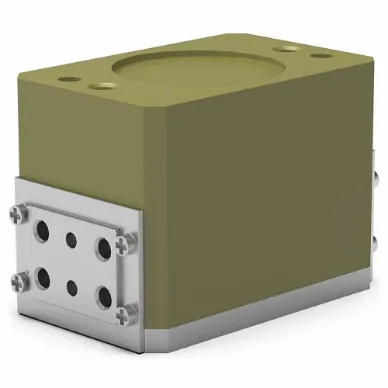Destaco RP-15 double wedge parallel gripper is designed for part positioning and repeatable operations in high-pressure applications, ensuring repeatability & accuracy. It is ideal for delicate part handling with valve controls, clean rooms & hostile environments, precise gripper fingers, and high temperature applications utilising internally sealed Viton. It is used in the automotive and electronics industries, where parts have predictable geometry. This parallel gripper uses a piston and compressed air to operate the jaws and deliver zero side play using low friction, Dual-V roller bearings. This lightweight and compact gripper is capable of offering grip force up to 70 lb, at pressures ranging from 40 to 100 psi. Destaco RP-15 gripper can operate at temperatures ranging between -30 degrees and 180 degrees Fahrenheit. The patented double wedge design of the gripper can offer extremely high grip force to ratio size and has a hardened steel bottom for part pressing applications. It is compatible with quick disconnect sensor cables, effect & resistive sensors, fail safe valves, sensor mounting kits and repair kits for high performance workholding, automation and containment solutions.
Uses:
Destaco RP-15 double wedge parallel gripper is used for delicate part handling with valve control, precisioned long gripper finger requirements and high temperature / pressure applications in the aerospace, automotive and food & packaging industries.
Features:
- Destaco RP-15 double wedge parallel gripper has Viton seals for high temperature applications.
- It offers excellent part repeatability and positioning.
- This gripper allows non-synchronous jaw operation with its 2 jaws, at temperatures ranging from -30 degrees to 180 degrees Fahrenheit.
- It features low friction, dual-V roller bearings to prevent sideplay.
- Destaco RP-15 parallel gripper has a lightweight and compact design for easy mounting.
- It is capable of providing 0.5 inch stroke with grip force of 70 lb.
- The patented double wedge design of the gripper can offer extremely high grip force to ratio size.
- This unit has a hardened steel bottom for part pressing applications.
Compatible Accessories:
- Destaco OSMK-003: These sensor mounting kits are designed for the brand's RP-15 double wedge parallel grippers.
- Destaco CABL-010 & CABL-013: These quick disconnect sensor cables have lengths of 2 mm (CABL-010) and 5 mm (CABL-013).
- Destaco (OFSV-001) & (OFSV-004): These fail safe valves are ideal for high performance workholding, automation and containment solutions.
Standards and Approvals:
Destaco RP-15 double wedge parallel gripper is ISO 9001:2015 and ISO 14001:2015 certified.
Installation:
- Destaco RP-15 double wedge parallel gripper has a thruster slide, rotary and gripper surface that allow easy and direct mounting.
Frequently Asked Questions:
Q. Does Destaco also supply water-resistant clamp sensors?
A. Yes, Destaco also offers inductive sensors designed especially in accordance with IP65 standards to provide protection from powerful hydraulic jets, dust & heavy rain
Q. What is the advantage of parallel gripper over angular gripper?
A. As the fingers fit into small areas, Destaco parallel grippers are capable of pulling a part down inside a machine whereas, the angular grippers are only used for getting tooling out of the way.
Q. Which grease is ideal for Destaco clamps for their rebuilding?
A. A coupling grease like Mobil XTC should be used when dealing with Destaco mechanical clamps, while the Magnalube G grease is great for use with pneumatic cylinder seals.
Q. What is the holding capacity of a clamp?
A. The holding capacity or holding force signifies the capability of a clamp to hold down mechanical equipment or sheet metal during automotive part assembling or similar manufacturing processes.
Q. What does clamping force mean?
A. Clamping force is the amount of force actually applied to the workpiece by closing & locking the clamp. It is normally less than the stated holding capacity. The actual clamping force depends on various factors, such as cylinder bore, cylinder area, spindle position (clamping arm length) and available air pressure. In most cases, the clamping force is approximately 2 to 3 times the force exerted by a pneumatic cylinder.
 Change Country
Change Country

